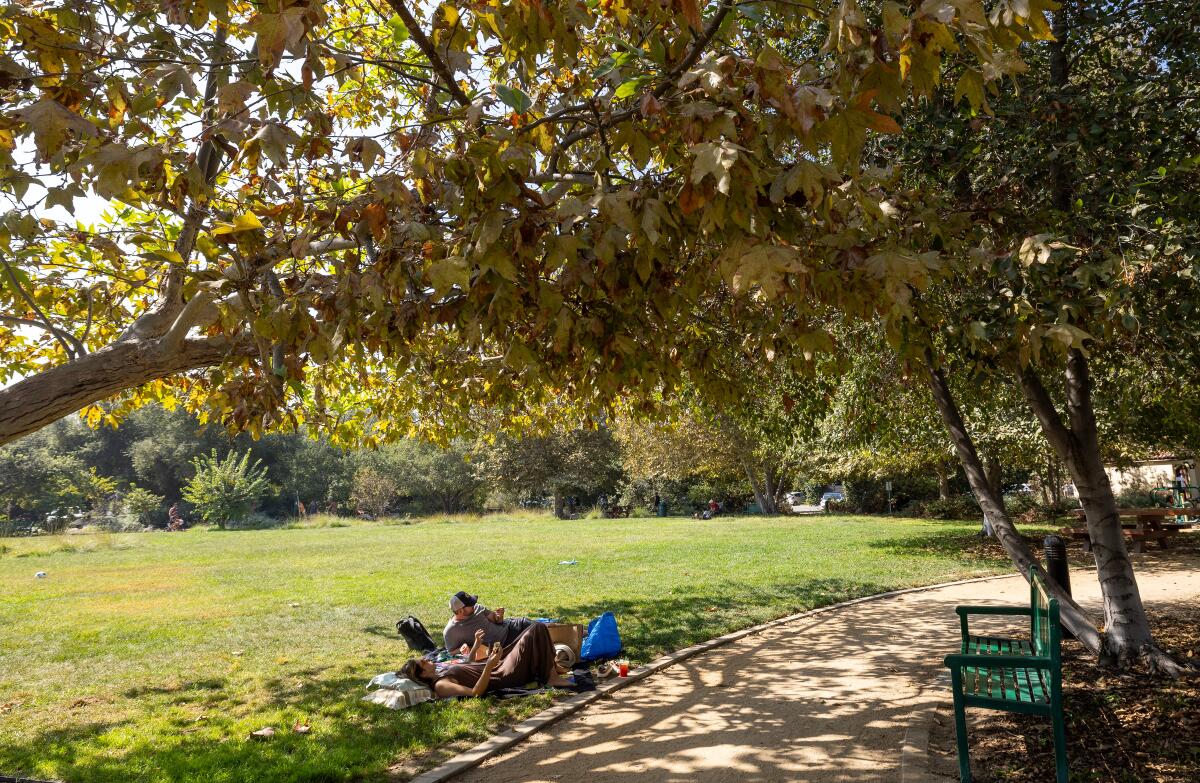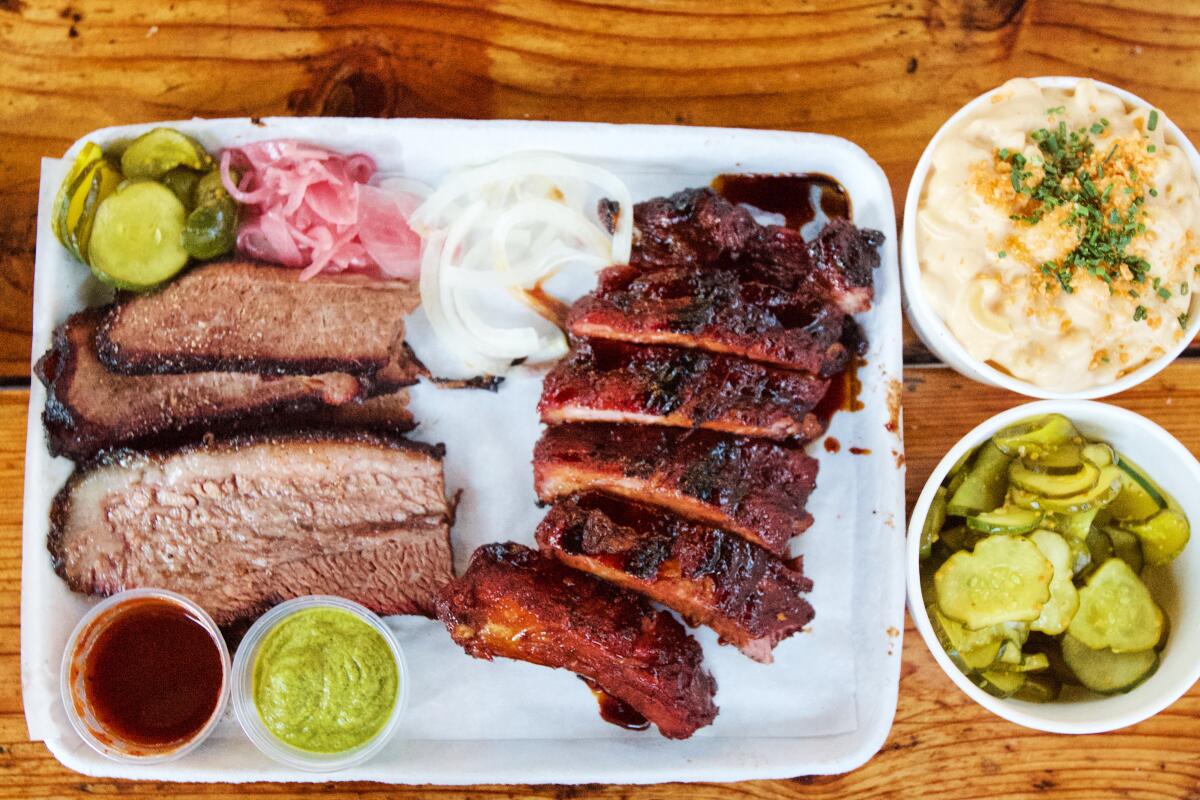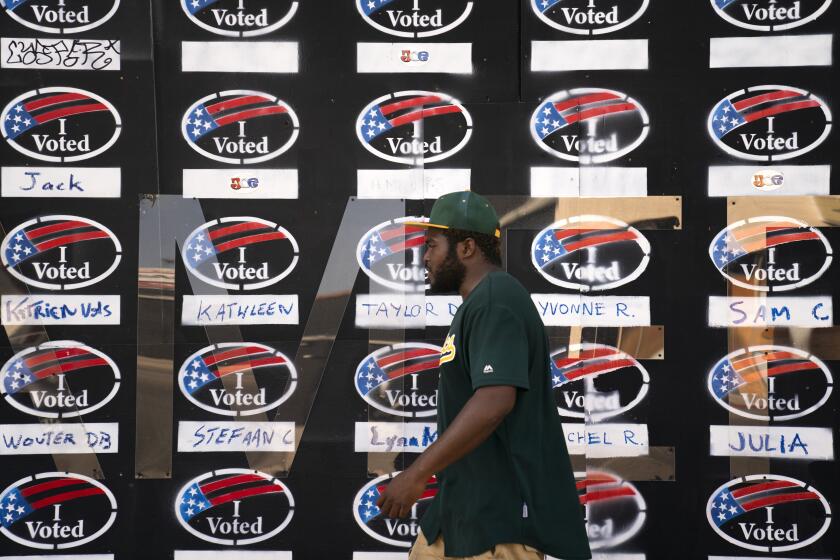Latinos in L.A.’s gentrifying Frogtown are fighting back. Solutions aren’t easy

Good morning. Here’s what you need to know to start your day.
- Frogtown’s flea market fracas and hard truths about gentrification.
- Could Trump really cut off wildfire aid for California? Absolutely.
- Today’s Dodgers parade is expected to bring 100,000 people to downtown L.A.
- And here’s today’s e-newspaper
Sign up for Essential California
The most important California stories and recommendations in your inbox every morning.
You may occasionally receive promotional content from the Los Angeles Times.
Does neighborhood revitalization have to result in community displacement?
Los Angeles’ Elysian Valley neighborhood is nestled on the western edge of the mighty L.A. River, hemmed in entirely by the 5 Freeway in the shape of a lazy M.
Now frequently called Frogtown, the community had historically been home to industrial working-class residents, a majority of whom were Latino.
But a decade of city-sanctioned redevelopment and revitalization projects in the neighborhood has been ratcheting up resentment among some residents. Earlier this month, the tension boiled over when a vocal group of neighbors blasted a popular flea market in public meetings and on social media, leading the event’s founder to shut it down permanently.
Residents complained that visitors to the Frogtown Flea Crawl clogged local streets with cars, left behind trash and foisted other nuisances on residents.

Times reporter Clara Harter recently examined the fracas and spoke with some who see this as one battle in a larger gentrification war playing out in Elysian Valley.
“Many [residents] believed that the venture was emblematic of the economic forces that are gradually erasing the tight-knit community they grew up in,” Clara wrote.
Frogtown’s story is a familiar one.
Over the past 10 years, the neighborhood got “hot” and has experienced the consequences that come with the label.
All the tell-tale signs of change are present: Art studios, coffee shops, a vegan bakery, a brewery, hip restaurants and pricey new housing developments popped up along the riverfront. This wasn’t by happenstance; it was made possible through rezoning by city leaders and on the coattails of a crackdown on local gangs and a long-term, $1.4-billion river revitalization project.
For some residents, the changes were a harbinger of what happened in nearby Silver Lake, Atwater Village and Highland Park: lower-income people being priced out of housing and displaced.
“The neighborhood went from being around 60% Hispanic or Latino in 2000 to 43% in 2022, while median household income rose from around $37,000 to $78,000 during that time,” Clara noted, citing U.S. census data.
Clara talked to Arturo Gomez, president of the Elysian Valley Riverside Neighborhood Council, who spoke with her as an individual in the community, He said present-day Frogtown “is unrecognizable from the neighborhood I grew up in.”
“A lot of my older … former neighbors have since moved away due to being priced out,” Gomez told her. “A lot of people will acknowledge that crime has plummeted as a result [of gentrification], but it shouldn’t have to take pricing people out to do that.”

Is displacement an inevitable effect of gentrification?
I put that question to Silvia R. González, director of research at UCLA’s Latino Policy and Politics Institute. She’s been documenting gentrification and displacement in L.A. for years and is focusing on strategies that protect vulnerable residents from the harms of economic revitalization.
“In historically marginalized, lower-income communities of color, these projects can unintentionally increase displacement pressures because these investments make ‘undesirable’ neighborhoods more attractive to people that can buy in,” she said, as in people with higher incomes and corporate investors.
To understand gentrification, González and fellow researchers look at four key metrics:
- Housing costs
- Income
- Education
- Race and ethnicity
Part of the problem, she said, is that L.A. and other cities have typically focused on increasing property values at the expense of those other markers, which is “not true progress.”
Other factors that should be considered, she noted, are affordable housing, positive income growth among existing residents and “educational attainment in the youth.”
“Growth that’s focused on property values alone is displacing vulnerable communities,” Gonzalez said.
But she believes it doesn’t have to be this way — if city leaders make the effort. Meaningful political will could mitigate displacement, she said, through affordable housing mandates, stronger tenant protections and sustained community engagement that puts residents “at the decision-making table.”
González pointed to some emerging models that give her optimism, like one in her own neighborhood of Pacoima. The San Fernando Valley community received a $23-million grant through the state’s Transformative Climate Communities to invest in parks, public transit and other amenities aimed at reducing emissions and air pollution.
Research from UCLA and UC Berkeley found that neighborhoods with increased development near transit rail stops often were seeing higher rents and more displacement.
That’s one reason community groups in Pacoima adopted a Displacement Avoidance Plan aimed at protecting residents and business owners from being priced out as revitalization ramps up.
“If we are only concerned about … corporate entities coming into our communities and buying up property and making money and we are not being thoughtful of how we protect the tenants [and] businesses that are there, protect the workers that are there, I think we miss out on an opportunity for the whole city to benefit,” González said.
Today’s top stories

Trump really could cut off wildfire aid for California if he returns to the White House
- Presidents have an extraordinary amount of discretion when it comes to disaster aid, which Trump reportedly wielded as a political cudgel during his presidency.
- The California Professional Firefighters union endorsed Harris in part because of Trump’s threats.
Election season is heating up. Here’s what you need to know
- Harris and Schiff enjoy big leads in California, but Biden’s victory was bigger in 2020, a poll found.
- Too many Democrats in Sacramento? The downsides of political dominance in California.
- L.A. D.A. George Gascón made strides in prosecuting police. Would a Hochman win change that?
- In two L.A. City Council races, police “abolition” is a wedge issue.
- A poll found Californians are uncertain about Proposition 32, which would boost the minimum wage to $18.
- Two recalls on the Oakland ballot show frustration about crime is “boiling over.”
Dodgers won the World Series. Let the celebrations begin
- Today’s World Series championship parade is expected to bring 100,000 people to downtown L.A.
- Ain’t no party like an East L.A. Dodgers party — and it didn’t stop.
- Don’t rain on our parade! A forecast storm should not affect today’s Dodgers celebration.
- Here’s a look inside the night the Dodgers won their eighth World Series title.
- The World Series scored close to 16 million viewers for Fox, marking a seven-year high.
What else is going on
- Undocumented migrants have no safety net for retirement. Many have no choice but to keep toiling.
- Joining Beverly Hills and Coronado in rebelling against state housing rules: this blue-collar city.
- ‘It didn’t have to be this way’: Beverly Hills settles investigation over abortion clinic battle.
- Boeing is looking to jettison the space business. Why it might hold on to its El Segundo satellite operation.
- Mortgage rates are rising. Experts cite economic strength, inflation and possible Trump win.
- Despite its name, South Park is park-poor. That could change.
Get unlimited access to the Los Angeles Times. Subscribe here.
Commentary and opinions
- Lopez: Harris or Trump? The outcome could be in the hands of voters 65 and older.
- Barabak: Is Ted Cruz Texas toast? Democrats would sure like to think so.
- Skelton: My take on the head-scratching California ballot measures.
- Editorial Board: ER patients are still being hurt by racial and gender biases.
- Litman: Does freedom itself depend on the outcome of this election? Donald Trump’s probably does.
This morning’s must reads

The Dodgers’ season started with Shohei Ohtani’s much-hyped L.A. debut after six seasons with the playoff-averse Anaheim Angels and ended with the biggest trophy in baseball. Times columnist Dylan Hernández looks back on how Ohtani drove himself to become a first-time World Series champion. “The title marked an appropriate end for the greatest individual season in Dodgers history,” Dylan writes, “one in which Ohtani became the first player in history to hit 50 homers and steal 50 bases.”
How can we make this newsletter more useful? Send comments to [email protected].
For your downtime

Going out
- 🗳️ Here are 16 spots where L.A. voters can stress eat, drink and get freebies on election day
- 📍 Looking for new activities? Google wants you to turn to its navigation app.
- 🎞️ A restaurant is a world unto itself in “La Cocina,” which The Times’ Mark Olsen calls one of the year’s freshest films.
Staying in
- 📱 Apple is trying to sell loyal iPhone users on AI tools. Here’s what Apple Intelligence can do.
- 🇺🇸 Keri Russell has been thinking about the vice president — in “The Diplomat” and real life.
- 📺 Ken Jennings apologized for a “problematic” clue on “Jeopardy!’ about girls who wear glasses.
- 🥧 Here’s a recipe for a double-crust apple pie.
- ✏️ Get our free daily crossword puzzle, sudoku, word search and arcade games.
A question for you: What’s one of your favorite scary movies?
Kenneth Buchanan writes: “‘Tales From the ’Hood’ starring Clarence Williams III, David Allen Grier, Joe Torry and Corbin Bernsen. Directed by Rusty Cundieff. This movie has comedy and social commentary. Real thematic issues discussed. This is a horror movie that does not get its just desserts as it should.”
And Joyce Alcouloumre writes: “Without a doubt my scariest movie was ‘The Picture of Dorian Gray.’ I was 10 when I saw it and had nightmares for a long time after. I am 90 and still remember it.”
And finally ... your photo of the day
Today’s photo is from staff photographer Jason Armond of fans in East L.A. celebrating the Dodgers’ victory over the Yankees to win their eighth World Series title on Wednesday.
Show us your favorite place in California! Send us photos you have taken of spots in California that are special — natural or human-made — and tell us why they’re important to you.
Have a great day, from the Essential California team
Ryan Fonseca, reporter
Defne Karabatur, fellow
Andrew Campa, Sunday reporter
Hunter Clauss, multiplatform editor
Christian Orozco, assistant editor
Stephanie Chavez, deputy metro editor
Karim Doumar, head of newsletters
Check our top stories, topics and the latest articles on latimes.com.
Sign up for Essential California
The most important California stories and recommendations in your inbox every morning.
You may occasionally receive promotional content from the Los Angeles Times.





